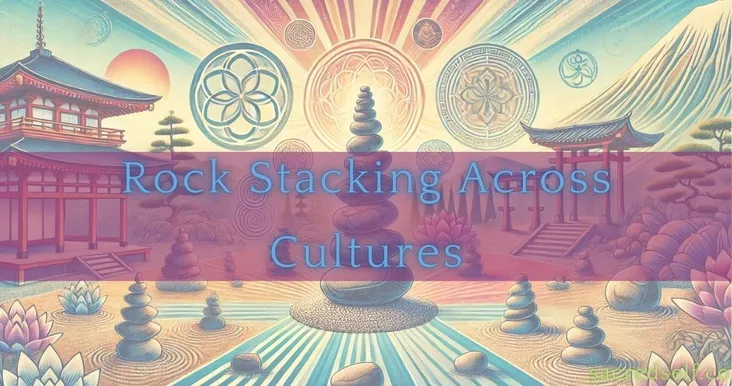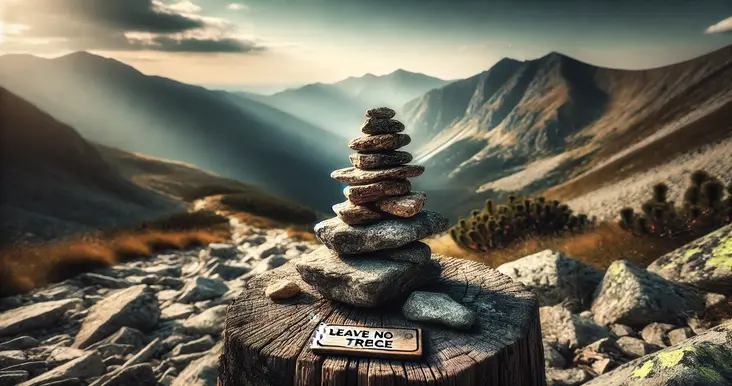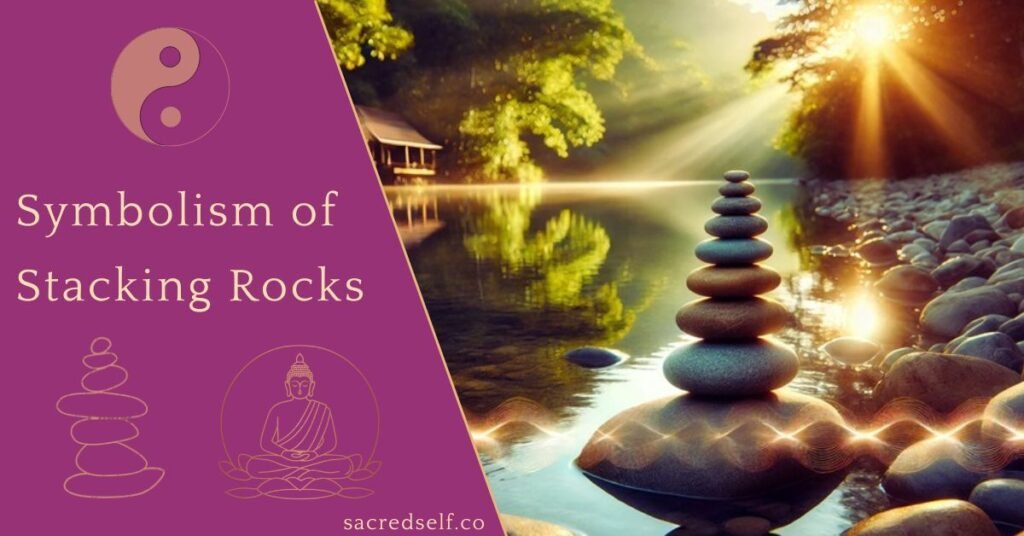Across continents and centuries, stacking rocks has become a universal symbol of balance, mindfulness, and spiritual growth.
In this article I’ll explore the various meanings and motivations behind stacking rocks in various cultures and traditions across the world, from Zen Buddhism to Greek mythology.
- Key Takeaways
- Table Summarizing Rock Stacking Symbolism Across Cultures
- Buddhism: Balance and Interconnectedness
- Hinduism: Stability and Devotion
- Greek Mythology: Milestones and Resilience
- Japanese Zen: Simplicity and Harmony
- Feng Shui: Balance and Grounding Energy
- Other Cultural & Historical Interpretations
- Environmental and Ethical Considerations of Stacking Rocks
Key Takeaways
-
Balance and Harmony: Stacking rocks symbolizes balance in life and nature, offering a mindful way to reconnect with yourself and your surroundings.
-
Cultural and Spiritual Symbols: From Buddhism to Hinduism, Greek mythology, and Japanese Zen, stacked rocks carry rich spiritual meanings that inspire reflection and gratitude.
-
A Meditative Practice: This simple act promotes mindfulness and focus, helping you stay grounded and present in the moment.
-
Personal Growth: Each stack can represent milestones, prayers, or intentions, making it a meaningful tool for self-reflection and inner peace.
-
Environmental Awareness: Stacking rocks responsibly ensures that you honour nature while enjoying its spiritual benefits.
Quick Guide on How to Stack Rocks Responsibly
-
Choose stones from disturbed areas to avoid disrupting habitats.
-
Refrain from stacking rocks in sensitive ecosystems like riverbeds.
-
Dismantle your stacks after meditation to preserve natural landscapes.
Table Summarizing Rock Stacking Symbolism Across Cultures
| Culture/Tradition | Meaning/Belief | Significance/Practice |
|---|---|---|
| Buddhism | Symbolizes impermanence and interconnectedness of all things. | Used in Zen gardens, meditation retreats, and as markers along spiritual journeys to encourage mindfulness and focus. |
| Hinduism | Represents stability, devotion, and alignment with the earth element. | Practiced in temple rituals, offerings at sacred sites, and pilgrimage routes as a form of prayer and grounding. |
| Greek Mythology | Symbolizes milestones, resilience, and tributes to gods. | Used as wayfinding markers, offerings to Hermes, and modern cairns for reflection and gratitude. |
| Japanese Zen | Reflects mindfulness, simplicity, and harmony through the principle of wabi-sabi. | Practiced in Zen gardens, meditation exercises, and as personal rituals to foster calm and balance. |
| Feng Shui | Represents balance, grounding energy, and stability in harmonizing environments. | Used as decor to balance the five elements, set intentions, and invite Chi into specific areas of the home. |
| Icelandic Folklore | Symbolizes gratitude and protection on journeys. | Travelers add stones to cairns to honor safe passage and connect with protective spirits. |
| Scottish Folklore | Represents tributes to the departed and offerings for protection. | Used to mark significant places like burial sites and sacred paths, ensuring safe journeys. |

Buddhism: Balance and Interconnectedness
In Buddhism, stacking rocks symbolizes impermanence and the interconnectedness of all things. Rooted in teachings like the Eightfold Path and Right Mindfulness, the practice promotes presence and mental clarity. Here’s how it holds significance:
Symbolic Meaning
- Impermanence: Each stack reminds practitioners of life’s transient nature and the need to find balance amid constant change.
- Interconnectedness: The stones represent harmony among the elements, illustrating how individual parts come together to create stability.
Examples of Practices
- Zen Rock Gardens: Zen monks use rock gardens, often with carefully placed stones, as tools for meditation. These gardens mimic natural landscapes and encourage reflection on simplicity and balance.
- Meditation Retreats: In countries like Japan and Korea, stacking rocks is incorporated into meditation practices, emphasizing mindfulness and focus.
- Personal Rituals: Practitioners stack stones along rivers or pathways as acts of devotion, often leaving stacks as markers of their spiritual journey.
Cultural Context
- Monastic Tradition: Buddhist temples in Japan, such as those in Kyoto, feature rock gardens where visitors and monks alike engage with the symbolism of stacking stones.
- Pilgrimages: Along Buddhist pilgrimage trails, travelers create stone stacks as offerings or prayers for guidance and protection.
- Daily Reflection: Some Buddhists practice stacking stones as part of their daily routine to cultivate a sense of calm and gratitude.

Hinduism: Stability and Devotion
In Hindu traditions, stacking rocks reflects spiritual grounding and devotion, symbolizing stability and alignment with the earth element. This practice is rooted in rituals and philosophies that emphasize balance and connection to the divine.
Symbolic Meaning
- Stability: Rocks represent the foundation of life, mirroring the strength and resilience needed to navigate challenges.
- Devotion: Stacked stones often serve as offerings to deities, symbolizing prayers for guidance, gratitude, or blessings.
- Earth Element: The practice connects to the earth element in Hinduism, grounding energy and fostering spiritual focus.
Examples of Practices
- Shila Nyasa (Foundation Rituals): Stones are ritually placed during temple construction to sanctify the foundation, representing stability and dedication to the divine.
- Offerings at Sacred Sites: Devotees stack stones near rivers, under sacred trees, or at temple entrances as symbolic prayers or acts of worship.
- Pilgrimage Traditions: Along pilgrimage routes like the Char Dham in India, travelers create stone stacks as expressions of devotion and gratitude for safe passage.
Cultural Context
- Connection to Nature: Stacking rocks aligns with the Hindu philosophy of respecting and honoring nature as a manifestation of the divine.
- Symbol of Karma: The act reflects karmic balance, urging practitioners to reflect on their actions and align with dharmic principles.
- Guided Meditation: Stones are sometimes stacked during yoga or meditation practices to symbolize grounding and spiritual growth.
Greek Mythology: Milestones and Resilience
In Greek mythology, stacking rocks, or cairns, held profound significance as markers of achievement and symbols of resilience. These stone piles were used to navigate physical and spiritual journeys, reflecting perseverance and growth.
Symbolic Meaning
- Milestones: Cairns marked progress on long journeys, symbolizing personal achievements or overcoming challenges.
- Resilience: Each stacked stone represented the strength needed to endure and thrive despite adversity.
- Offerings to the Gods: Cairns were often created as tributes to deities, seeking their guidance or expressing gratitude.
Examples of Practices
- Wayfinding Markers: Travelers in ancient Greece built cairns along paths to guide others through difficult terrains, such as mountainous regions or forest trails.
- Tributes to Hermes: As the god of travelers and boundaries, Hermes was honored with cairns, which were seen as protective and guiding symbols.
- Modern Inspirations: Today, hikers and travelers stack stones at significant locations in Greece, continuing the ancient practice as acts of reflection or homage.
Cultural Context
- Journey Symbolism: Cairns were deeply tied to the concept of life as a journey, emphasizing progress, reflection, and resilience.
- Community Contribution: Stacking stones was often a communal act, with travelers adding to existing cairns to signify collective effort and shared purpose.
- Contemporary Practices: Beyond Greece, this tradition has inspired modern travelers worldwide, who build cairns to commemorate personal milestones or as acts of gratitude during their journeys.
Japanese Zen: Simplicity and Harmony
In Japanese Zen traditions, stacking rocks reflects principles of mindfulness, simplicity, and balance. Rooted in the philosophy of wabi-sabi—which finds beauty in imperfection—this practice promotes focus and a connection to nature.
Symbolic Meaning
- Mindfulness and Presence: The act of stacking rocks requires intention and focus, encouraging a meditative state.
- Wabi-Sabi: Each stack represents the transient and imperfect nature of life, fostering acceptance and inner peace.
- Natural Harmony: Rocks in Zen gardens symbolize elements of nature, such as mountains or islands, blending the physical and spiritual worlds.
Examples of Practices
- Zen Gardens:
- Famous sites like Ryoanji Temple in Kyoto use carefully arranged stones to inspire meditation and reflection.
- Rocks are often placed to mimic rivers, mountains, or islands, symbolizing the interconnectedness of all things.
- Meditation Rituals:
- Practitioners stack stones as a mindfulness exercise, aligning each piece with deliberate intention.
- The activity helps clear the mind, fostering simplicity and tranquility.
Practical Tips
- Create a small Zen corner at home with stacked rocks, sand, and greenery to encourage a sense of calm.
- Use rock stacking as a meditative practice, focusing on the alignment and balance of each stone to cultivate mindfulness.
Feng Shui: Balance and Grounding Energy
In Feng Shui, the ancient Chinese practice of harmonizing energy (Chi) in our surroundings, stacking rocks represents balance, stability, and positive energy flow. This practice invites grounding energy and enhances harmony in your environment.
Symbolic Meaning
- Creating Balance: Each stone in a stack symbolizes layers of physical and emotional stability, mirroring life’s balance.
- Grounding Energy: Stacked rocks anchor energy in the present moment, promoting calmness and focus.
- Intention Setting: Stones can hold aspirations like success, clarity, or healing, turning the act of stacking into a spiritual exercise.
- Earth Element: Stacked rocks enhance the earth element in Feng Shui, symbolizing support, grounding, and stability.
Placement in Your Space:
- Place rock stacks in the north or northeast areas of your home to encourage grounding energy and stability.
- Use rocks as decor on desks or in gardens to promote tranquility and harmonious energy flow.
Other Cultural & Historical Interpretations
In Icelandic and Scottish folklore, stacked rocks, often in the form of cairns, served as essential landmarks, guiding travellers safely through desolate landscapes. Beyond their practical use, these cairns evolved into symbols of gratitude and protection.
- Icelandic Traditions: Travelers added stones to cairns to express thanks for safe passage and to honour those who journeyed before them. Cairns was also believed to house protective spirits that safeguarded the road ahead.
- Scottish Folklore: In Scotland, cairns often marked significant places such as burial sites or sacred paths. Travellers built them as tributes to the departed or as offerings for protection during their journeys.

Environmental and Ethical Considerations of Stacking Rocks
While stacking rocks is a meaningful spiritual practice, it’s essential to balance this connection to nature with responsibility and respect. When done without care, rock stacking can harm ecosystems and disrupt cultural sites, diminishing the practice’s intended harmony with the natural world.
Why Consider the Environment?
- Ecosystem Disruption: Rock stacking can disturb delicate habitats. For example, aquatic insects, fish, and other small organisms often rely on submerged rocks for shelter and breeding. Removing or rearranging these rocks exposes them to predators and erosion.
- Cultural Sensitivity: In many regions, rock formations hold sacred or historical significance. Unknowingly disturbing these areas can be disrespectful to local traditions or indigenous cultures. Researching the location’s cultural importance before stacking rocks is vital.
How to Practice Responsible Rock Stacking
To ensure that this spiritual activity remains respectful to nature and culture, follow these principles:
- Follow Leave No Trace Principles: Respect the integrity of the landscape by adhering to Leave No Trace guidelines: “Take only memories, leave only footprints.” This ensures your interaction with nature is temporary and non-invasive.
- Use Rocks from Disturbed Areas: Choose stones that are already displaced or from non-sensitive zones, avoiding habitats like streambeds and riverbanks where rocks serve critical ecological purposes.
- Dismantle After Use: The act of stacking rocks is more significant than the permanence of the structure. Dismantling your stacks after your practice helps preserve the natural environment for others to enjoy.
- Avoid Protected Areas: Steer clear of stacking rocks in national parks, protected wildlife zones, or cultural heritage sites where rock formations may serve ecological or cultural roles.
- Please focus on the Process: Embrace the practice for its spiritual and meditative value rather than leaving a physical mark. Let the stacking process reflect mindfulness, impermanence, and connection to the present moment.
- Spread Awareness: If introducing this practice to others, educate them on its potential environmental impacts and encourage ethical practices to protect natural habitats and cultural significance.
FAQs
What is the difference between rock stacking and rock balancing?
While the terms are often used interchangeably, rock stacking typically refers to the intentional placement of stones to create stable structures (like cairns). Rock balancing involves arranging stones in precarious positions to achieve balance, often as a form of artistic or meditative expression.
Can stacking rocks harm the environment?
Yes, if done irresponsibly. Moving rocks from their natural positions can disrupt ecosystems, especially in riverbeds where rocks provide shelter for aquatic life. It’s important to practice ethical rock stacking by avoiding sensitive areas and dismantling stacks after use.
What does the Bible say about stacking stones?
In the Bible, stacking stones symbolizes remembrance and faith. For instance, in Joshua 4:20-22, the Israelites stack stones to memorialize God’s guidance during their journey. Similarly, stone stacking today can represent gratitude, milestones, or moments of reflection, serving as a meaningful expression of one’s faith.
What is the meaning of balancing rocks?
Balancing rocks reflects the quest for harmony amidst life’s chaos. Each stone can symbolize an aspect of life—relationships, work, or challenges—and the act of balancing mirrors our efforts to maintain stability. It’s a meditative practice that keeps you present and grounded while celebrating both balance and imperfection.
Can stacking rocks improve mental health?
Yes, the practice of stacking rocks is meditative and can reduce stress. It requires focus and presence, which can help quiet a busy mind and foster a sense of calm and balance.
What materials can I use for stacking rocks?
The best materials for stacking are natural, loose stones found in non-sensitive areas. Avoid taking rocks from habitats like streambeds or culturally significant sites. The act of stacking is about mindfulness, so even pebbles or small stones can be used.
What is stone stacking called?
Stone stacking is commonly referred to as cairn building, rock balancing, or trail marking. In Zen practices, it’s known as ishi-tate (stone standing), while spiritual seekers might call them prayer stacks. Regardless of the name, the essence is the same: a meditative act of creating harmony in nature while reflecting on your personal journey.
Is it good to stack rocks?
Yes, when done responsibly. Stacking rocks is a calming activity that promotes mindfulness, focus, and balance. However, it’s important to practice ethically by respecting local ecosystems and cultural sensitivities.
Final Words
Whether you’re connecting with traditions in Buddhism, Hinduism, or Greek mythology or embracing mindfulness through Zen practices, the simple act of balancing rocks can bring focus and calmness in your life.
Sometimes is enough to just watching someone stacking rocks to bring a quick sense of peace into your life.
But if you do take action and start stacking rocks yourself, please remember to stack responsibly, respecting nature and its ecosystems.
Namaste. 🙏
More relevant posts
This post may contain affiliate links. As an Amazon Associate, and as an affiliate of other online retailers, we earn from qualifying purchases - this means that if you buy something through a link, we may earn a small commission at no extra cost to you.



